I just reviewed the Hisense U7K Mini-LED TV — and it’s amazing for under $800
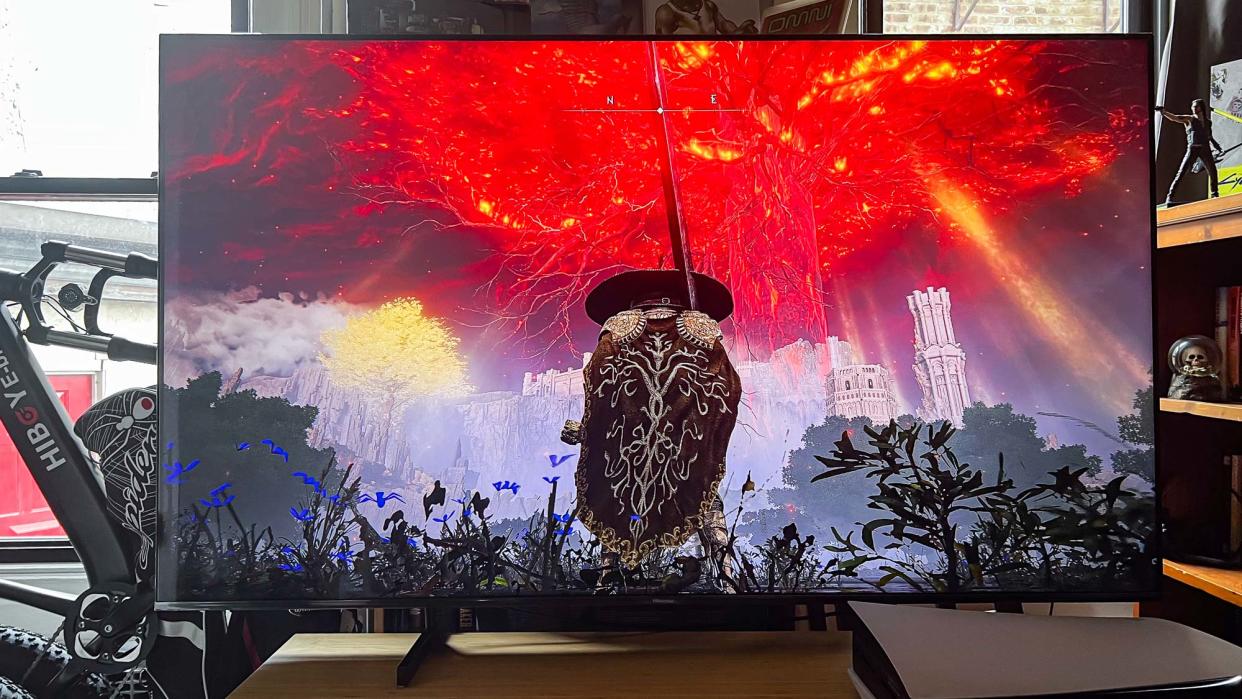
The Hisense U7K Mini-LED TV is a value option and a remarkable performer with a budget sticker price, making itself known as one of the newest best budget TVs on the block. Although it mirrors other options in Hisense 2023 lineup, the U7K comes equipped with stellar color coverage, gaming performance, and audio quality. It's quite a feat to behold when sitting in a darker environment, and at just around $800 you're getting that full package with little to say in regards to its downsides.
Its use of Google TV streamlines the entertainment search process and gifts it one of the snappiest interfaces I've seen, and the fact that users can simply press a desired app on the remote and jump right into that particular content hub (even if the TV is turned off) keeps users in the flow of content.
The Hisense U7K is quite the all-arounder, hitting that sweet spot of 144Hz for gamers while also leveraging its own Game Bar that users can easily set VRR and other settings at a clip. It may not be as sophisticated as LG's beloved gaming bar as seen on the LG C3 OLED, but it still proves to be a remarkable selling point, with features that may well pit it among the best gaming TVs.
But, enough of that, let's see how the Hisense U7K truly stands up against major competitors in the space. Read my full Hisense U7K mini-LED review below to learn more.
Hisense U7K Mini-LED TV review: Price and release date
The Hisense U7K Mini-LED TV is among Hisense’s 2023 TV lineup, which also features the Hisense U6K and Hisense U8K. It’s in the middle of the road within last year’s TV launch, beat out by both the 85-in Hisense UX TV and the aforementioned U8K.
Our testing follows on the 65-inch model of the Hisense U7K, but this TV also comes in a slightly smaller 55-in model, as well as both 75-in and 85-in for those who may want a bit of a larger image. You can always check out our what size TV should you buy page to know just what screen is right for you before making a final purchase.
55-in Hisense U7K Mini-LED TV (55U7K) - $629.99 ($599 on sale)
65-in Hisense U7K Mini-LED TV (65U7K) - $799.99 ($729 on sale)
75-in Hisense U7K Mini-LED TV (75U7K) - $1,129.99 ($999 on sale)
85-in Hisense U7K Mini-LED TV (85U7K) - $2,199.99 ($1,699 on sale)
Pricing on the Hisense U7K is quite good, especially given that it tends to be on sale for hefty bargains. In comparison with its U7H counterpart from 2022, the Hisense U7K sits right around or even under the U7H’s price. It’s quite the budget option and yet still provides a well-rounded experience.
Hisense U7K Mini-LED TV review: Design
The Hisense U7K looks and feels like most other Hisense TVs — it’s quite hefty, bezels are pretty noticeable on the sides, and it leverages two feet as stands. For all intents and purposes, it appears almost identical to its U8K brethren, sporting the same dual legs as stands and general screen look.
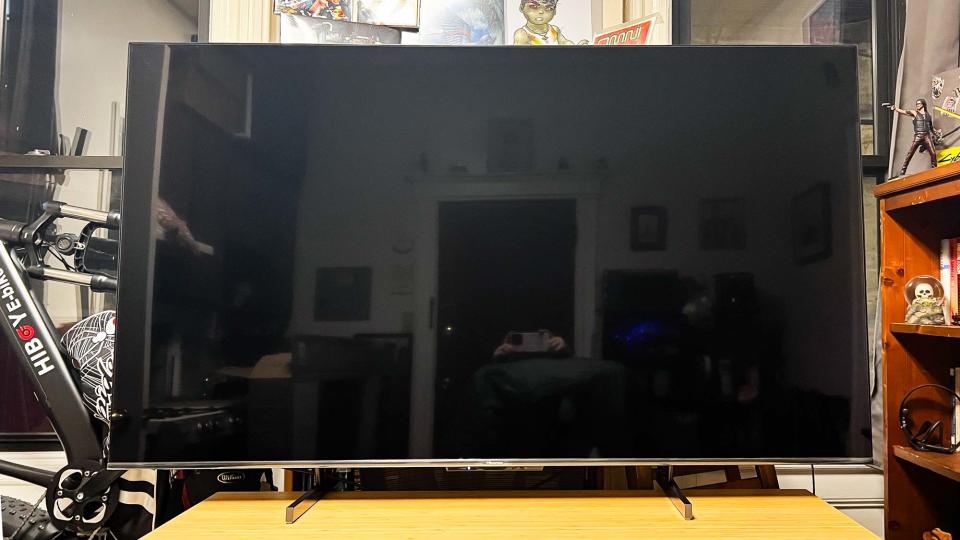
The Hisense U7K leverages a VA panel with a depth of 10 bits. For backlighting, given its name, the U7K uses Mini-LEDs that populate the screen, which gifts the display its gorgeous color and brightness levels.
Although I have it setup with its stand configuration, the U7K can be attached to a wall using its 400 x 200 mm VESA mount. The removable stand, while easy to install, is somewhat of a nuisance in that the TV sort of wobbles back and forth from its foundation. I tried to twist the supports in a bit to give the legs better depth within the TV, but found it didn't help much. Thus, mounting on a wall will most definitely be the better play for the Hisense U7K.
Hisense U7K Mini-LED TV review: Ports
Like the U8K, the Hisense U7K likewise comes equipped with four HDMI 2.1 ports, 2 of which are 4K @ 144Hz, and one being eARC for soundbars and assorted audio connections. There are also 2 USB ports (1 USB 2.0 and 1 USB 3.0), digital optical output, ethernet, and even an RF Antenna Input, allowing users to connect an ATSC 3.0 tuner.
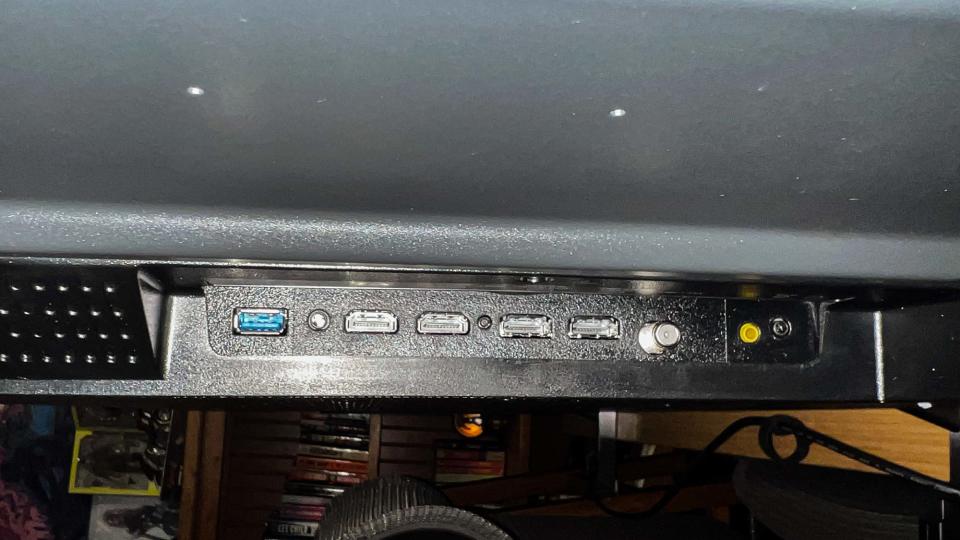
You won't be hurting for any necessary ports on this display, especially given the fact that several among 2024 TVs will be sporting only 2 or 3 HDMI ports. Both the bottom two are HDMI 2.1 and specify 144Hz as their main advantages, allowing both gaming consoles, like a PlayStation 5 or Xbox Series X, or even a PC to run games at an optimal pace — primarily at 120 fps despite the higher number.
Hisense U7K Mini-LED TV review: Performance
I cannot praise the Hisense U7K enough for its remarkable color coverage. It seemingly takes inspiration from Samsung's The Frame, looking like a cross between a painting and a sophisticated display. Studio Ghibli's "Howl's Moving Castle" and the newest episodes of "Frieren: Beyond Journey's End" looked exceptional on it.
The U7K takes on this magical glow, especially when used in darker settings thanks to its HDR brightness coverage. Animated content really pops right off the screen, and you can see particular details come to life in extraordinary ways, like the vibrancy of the world below both Howl and Sophie's feet.
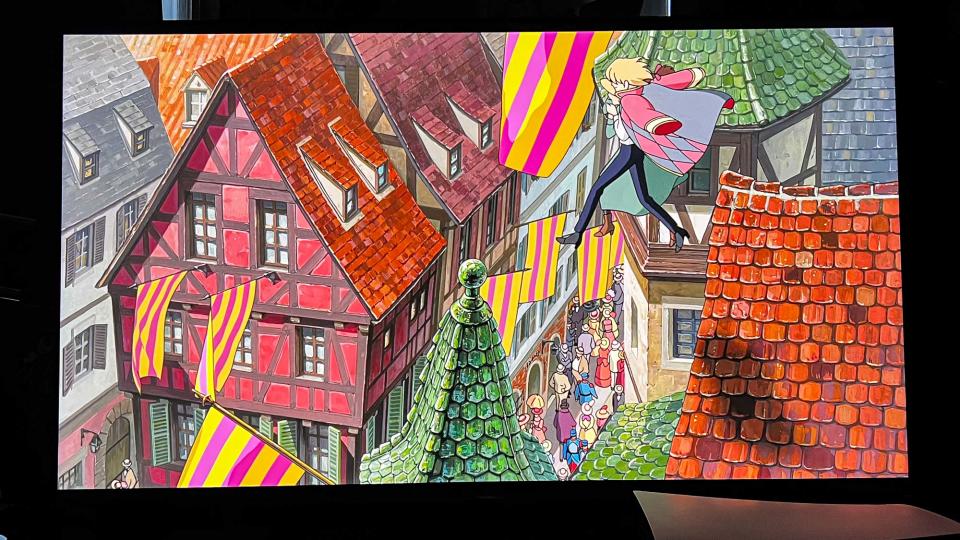
Although it's got some great color saturation, the same cannot be said for action-heavy content. The most recent Super Bowl 2024 proved to be a relative bummer. The Hisense U7K's 4K upscaling didn't meet that same level of sophistication as seen in its vibrancy. The same could be said of its motion-processing, which didn't exactly look great and can be felt in the blurred movements presented by the Kansas City Chiefs' offense.
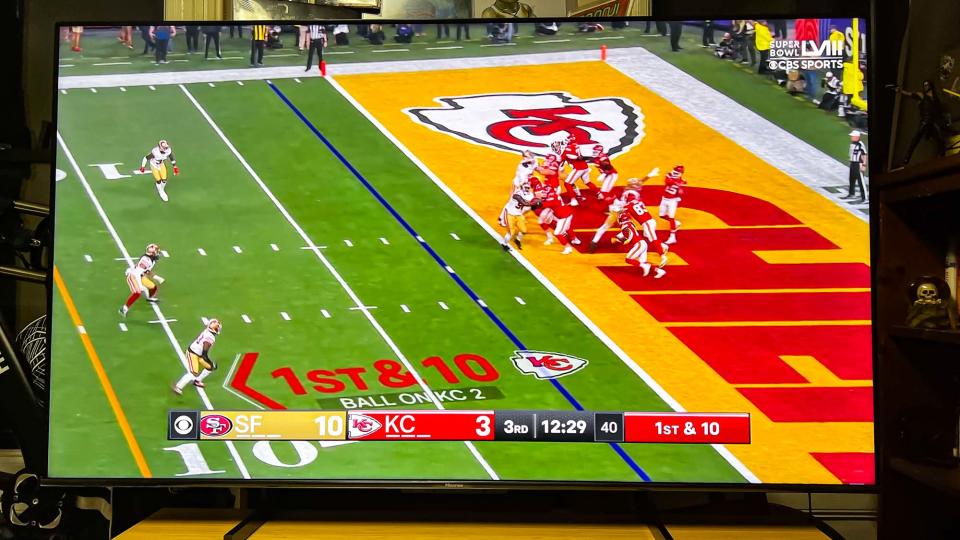
Given that Super Bowl 2024 was played in 1080p on Paramount Plus, the Hisense U7K had to do a lot of the heavier lifting in upgrading the content to 4K. The Hi-View Engine, Hisense's onboard chip for the U7K, clearly chugged to ensure the content looked smooth and unblemished. While it still definitely wasn't an awful experience, there's better TVs for experiencing this type of content.
As for general 4K content, the U7K is a stunner. The neon-glitzed world of HBO Max's "Tokyo Vice" truly comes to life with brilliant contrasts. The sinister Yakuza boss is highlighted in great detail with the backdrop of Tokyo behind him, and subtitles come in without diminishing the overall picture tones and light bleed.
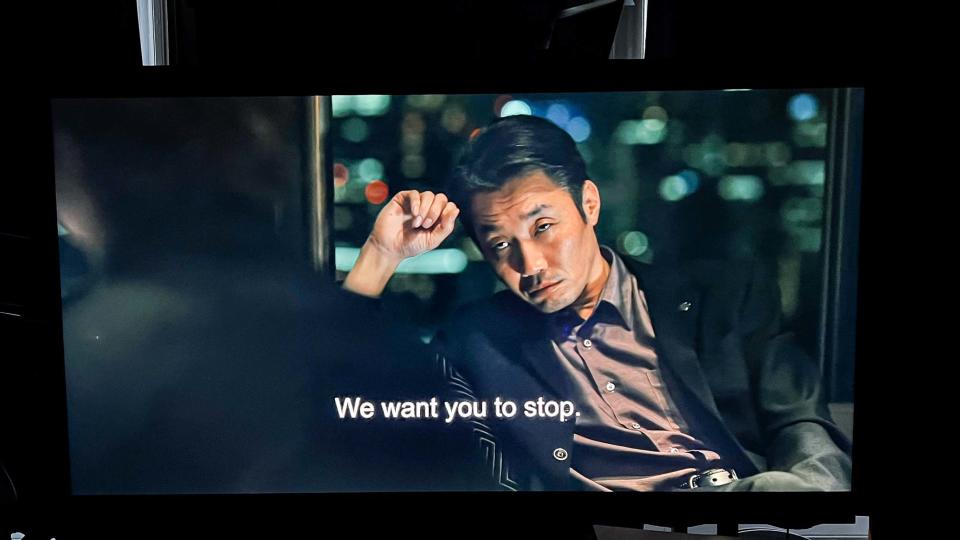
Hisense U7K Mini-LED TV review: Test Results
To get some quantitative testing data we used an X-Rite i1 Pro spectrophotometer, a SpectraCal VideoForge Pro pattern generator, and Portrait Displays’ Calman calibration software to put the Hisense U7K up against its toughest competitors: the TCL Q7, LG C3 OLED and Samsung Q60C QLED TV.
Color and brightness both prove quite remarkable on the Hisense U7K. It certainly shows in the testing data how far the brightness hits in certain areas set across the screen. You can see how the performance even catapults a bit for HDR content, reaching as high as 715 nits, making it pop most especially in darker settings.
Though, while it does have some great brightness, the Hisense U7K shines brightest via its color volume. It might not hit quite a high sweet spot for its Rec 2020 coverage (79.8%), but it does have some phenomenal stats on the UDHA-P3 (98.13%) and Rec709 gamuts (99.79%). This is best of experienced in more animated content as seen in Studio Ghibli's "Howl's Moving Castle," with the magical backdrops coming to life in a swirl of vibrant colors.
It's also got a really astute gaming potential in its 13.2ms of input lag, just a bit over the base 10ms mark for the most optimal gaming performance. You won't be left behind by other players when sporting the Hisense U7K, as its 144Hz ensures you're getting the most optimal coverage for fps games, utilized best when paired with a PC.
Hisense U7K Mini-LED TV review: Gaming

Gaming on the Hisense U7K was its most impressive feat. The colorful open-world of “Elden Ring” on PlayStation 5 proved remarkable to explore thanks to the potential provided in playing at 4K/60fps via HDMI 2.1. While it's nowhere near an OLED TV, I was still pleasantly stunned by the color volume and overall performance of the U7K when it came to gaming.
Thanks to its incredible brightness, you won’t have to worry about ambient light getting in the way of your experience, as the U7K dissipates light pretty well. It also leverages AMD FreeSync Premium Pro to alleviate any potential screen tearing that my occur. Other gaming-centric additions include VRR, Dolby Vision Gaming, and even a newly included gaming bar.
While it’s nowhere near as extensive as LG’s or Samsung’s offerings, the Hisense game bar does streamline the settings a bit and you can even add a handy FPS counter to the top of the screen if you want to track the performance. Its input lag of 13.2ms, mirroring its U8K counterpart, is quite good as well.
Running "Armored Core 6," which essentially has an uncapped frame rate, was also a pretty fun experience when pairing my mini PC with the Hisense U7K. Although I had to play in 1080p and lower settings, the game still looked pretty awesome, and hitting those highs of 70+ fps was a real treat thanks to the U7K's potential in that area.
FPS games, like "The Finals" and "Modern Warfare 3," also came with some stellar performance. If you're not one for the RPG, but prefer the more fast paced action provided in arena shooters or battle royale experiences, then the U7K will still be a stellar ticket to phenomenal gameplay.
Hisense U7K Mini-LED TV review: Audio
The U7K is equipped with a 2.1 channel speaker at 50W. While you definitely could get improved quality out of a soundbar attached to the U7K, sounds are still punchy and its volume can hit some pretty high levels. I usually kept the volume at around the 15 and under mark as anything over that was far too loud for comfort.
For those looking for a bit more depth and detail, especially for content that might be lower in volume, I would recommend one of the best soundbars. Its included leg stands allow for enough room to fit a soundbar under the display, so you won’t have to worry about clearance issues.
I was still pleasantly surprised by the U7K’s sound profile though and wouldn’t worry too much if you don’t have the budget for a soundbar or speaker.
Hisense U7K Mini-LED TV review: Interface and apps
There’s a reason so many brands are now moving to Google TV over Roku and Android, due in large part to Google’s simplicity in the set-up phase and positive overall user experience.
That being said, though, I did have trouble setting up the internet using Google’s hub via my smartphone. This has happened before and while it’s not too much of an issue and not necessarily the TV’s fault, it’s good to know that you may have to type out your WiFi password on the TV rather than your phone. It’s a little frustrating, but Google does most of the rest of the heavy lifting, main among them being automatically logging into apps.

I was actually pleasantly surprised by the U7K’s snappy and intuitive OS. Right out of the box, navigating it UI was swift and slick. You also have the benefit of instantly downloading (and logging into) many of your most-used apps with a single click — thanks Google — which seamlessly streamlines access to all of your varied entertainment needs.
I can see a world where this slows slightly over time, but probably not that dramatically. It’s more so switching between apps where things get a bit muddled. While loading into apps after switching between them can be somewhat slow, it shouldn’t be a major deal breaker.
One thing to note is that the U7K can utilize a camera for specific hand-activated prompts, like muting or raising/lowering the volume and even turning off the TV. When I tried this using DJI’s Osmo Pocket 3, it didn’t work for me and I unfortunately don’t have any other camera to try it with so while somewhat of a bummer I do still think it’s a pretty cool option for those who want it — though, you may want to use an actual webcam as opposed to a more sophisticated camera.
Google TV also includes practically any app you would want, with few being left out of the equation, so you won’t have to worry about general entertainment coverage.
Hisense U7K Mini-LED TV review: Remote
There’s little to complain about when it comes to the U7K’s remote. It not only comes equipped with a variety of hot buttons for the most commonly used apps, like Disney Plus and YouTube, but also even has an Apps button to quickly jump to your downloaded applications for easy access to content. When the TV's turned off, users can even press a particular button, say Prime Video, and the Hisense U7K will open directly into that app.
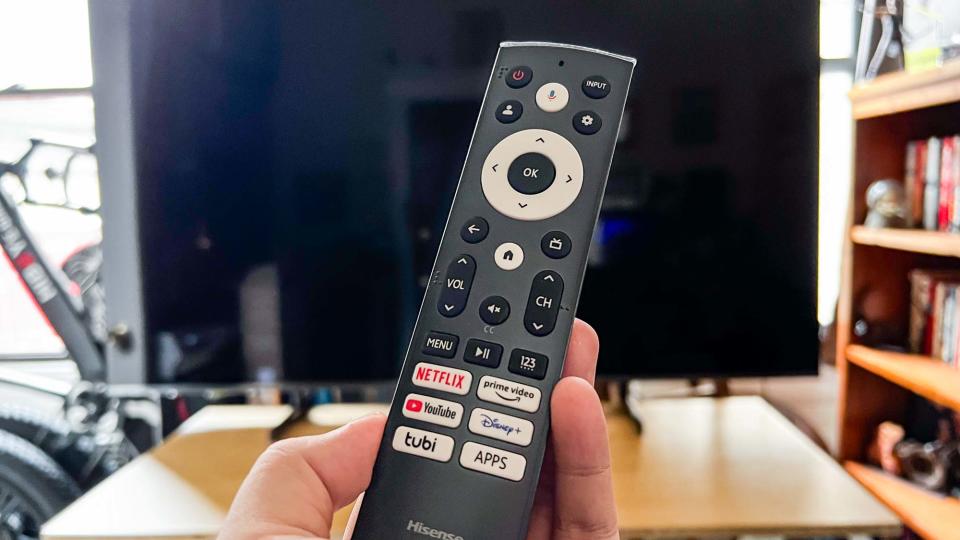
Additionally, the U7K remote has voice-activated features streamlining the entire search process. Users can also easily find the remote via Hisense’s remote finder feature, which is quite a nice touch, especially for someone like me who constantly loses the remote in the cushiony abyss of the couch.
Still, while the remote feels good in the hand and is weighty enough to not seem cheap, it does seem lackluster when compared to more advanced options out there made via competitors, like LG and Samsung. The latter, for one, uses a remote that can charge not just through sunlight but also via RF energy on one’s WiFi router, which is quite the feat and makes Hisense’s remote look a tad outdated.
Hisense U7K Mini-LED TV review: Verdict

The Hisense U7K Mini-LED TV is a stellar performer, one that truly doesn't match its price — in a good way. For just around the $800 mark, you're gifted stellar specs and gaming performance. The U7K definitely looks best in a darker environment, one with limited ambient lighting — though that's not to say it's not good in a sun-drenched room thanks to its 700 nits of peak brightness.
Action-packed movies and sub-1080p content aren't ideal given the limited motion processing and upscaling potential, but the U7K still gets the job done. Few if any of your friends will notice the major drawbacks as the overall experience is one to truly cherish, and your wallet will certainly be happy, too.
